Free Pay or Quit Notice Forms
Being a landlord comes with its challenges along with its benefits. But it can seem especially difficult when you’re dealing with tenants who don’t pay rent or who consistently pay their rent late.
While every state allows landlords to evict tenants who don’t pay their rent, it is important to follow the right protocols to collect rent or start the eviction process.
This article will go over how you can use notice to pay or quit forms to provide notice to pay rent or start an eviction. We’ll cover when and how to use these forms, how to fill them out, and everything else you need to know.
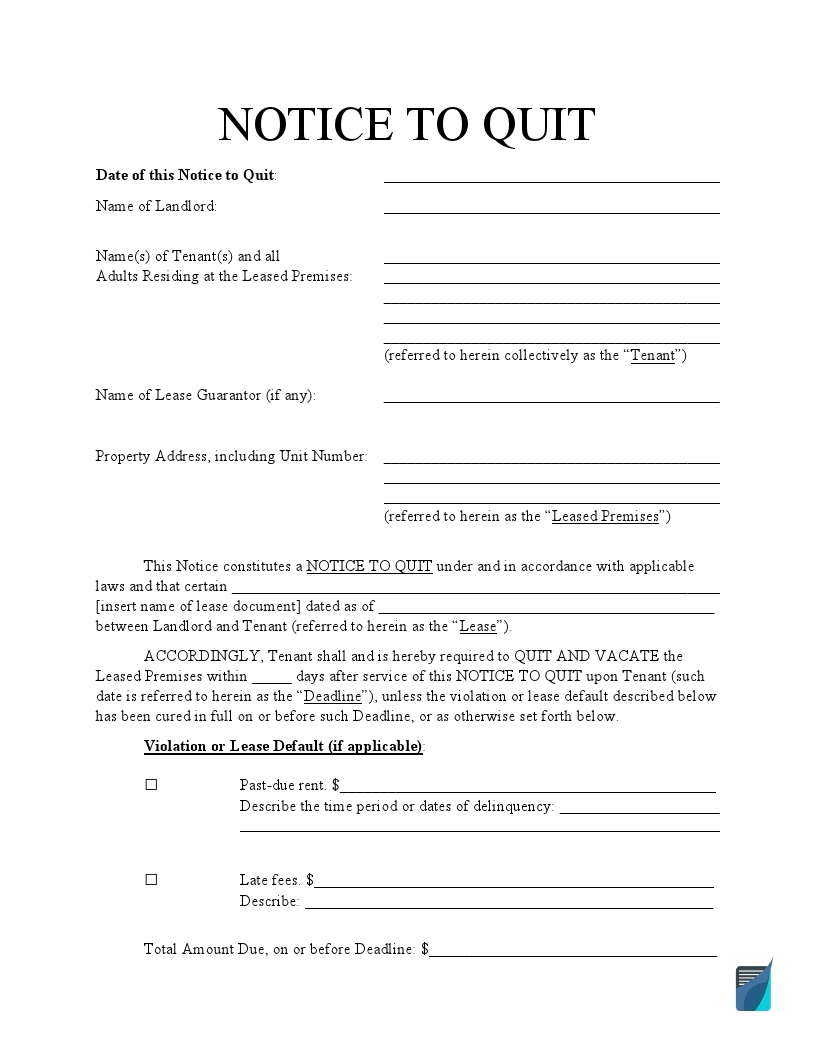
Build Your Document
Answer a few simple questions to make your document in minutes
Save and Print
Save progress and finish on any device, download and print anytime
Sign and Use
Your valid, lawyer-approved document is ready
What is a Notice to Pay or Quit?
A notice to pay or quit is usually the second form you send to a tenant that is behind on their rent. It’s also usually only available after your tenant has missed more than one month’s rent.
These forms are used to do one of three things:
- Collect back rent and maintain a normal landlord-tenant relationship
- Give a tenant the opportunity to leave a property without further legal proceedings
- To terminate a lease agreement and start the eviction process (if rent is not paid)
Of course, there are other types of eviction notice template that are similar, and that may be a better option depending on the situation and your state’s laws.
Notice to Pay or Quit Laws by State
| STATE | Notice Periods | Late Rent Grace Periods | Max. Late Rent Fees |
| Alabama | 7 Days (AL Code Section 35-9A-421) | No Statute | No Statute |
| Alaska | 7 Days (AS Section 34.03.220) | No Statute | No Statute |
| Arizona | 5 Days (A.R.S. Section 33-1368) | No Statute | “Reasonable,” Section 33-1368 |
| Arkansas | 3 Days (AR Code Section 18-17-701) | 5 Days, Section 18-17-701 | No Statute |
| California | 3 Days (CA Civ Pro Code Section 1161) | No Statute | “Reasonable,” CA Civ Code Section 1671 |
| Colorado | 10 Days (CO Rev. Stat. Section 13-40-104) | No Statute | No Statute |
| Connecticut | 3 Days (CT Gen Stat Chapter 832, Section 47a-23) | 9 Days, Section 47a-15a | No Statute |
| Delaware | 5 Days (Del. Code Section 25-5502) | 5 to 8 Days, Section 25-5501 | 5% of Rent, Section 25-5501 |
| Florida | 3 Days (FL Stat Section 83.56) | No Statute | $20 or 20%, Section 83.808 |
| Georgia | Immediate (GA Code Section 44-7-50) | No Statute | No Statute |
| Hawaii | 15 Days (HRS Section 521-68) | No Statute | No Statute |
| Idaho | 3 Days (ID Stat Section 6-303) | No Statute | No Statute |
| Illinois | 5 Days (ILCS Chapter 735, Section 5/9-209) | 5 Days (ILCS Chapter 770, Section 95/7.10) | No Statute |
| Indiana | 10 Days (IC Section 32-31-1-6) | No Statute | No Statute |
| Iowa | 3 Days (IA Code Section 562A.27) | No Statute | $12 to $20 per Day, Section 562A.9 |
| Kansas | 10 Days* (KS Stat Section 58-2507) | No Statute | No Statute |
| Kentucky | 7 Days (KRS Section 383.660) | No Statute | No Statute |
| Louisiana | 5 Days (CCP, Article 4701) | No Statute | No Statute |
| Maine | 7 Days (MRSA Section 6002) | 15 Days, Section 6028 | 4% of Rent, Section 6028 |
| Maryland | 10 Days (MD Real Prop Code Section 8-401) | No Statute | 5% of Rent, Section 8-208 |
| Massachusetts | 14 Days (MGL Chapter 186 Section 12) | 30 Days, Chapter 186, Section 15B(1) | No Statute |
| Michigan | 7 Days (MCL Section 554.134) | No Statute | No Statute |
| Minnesota | 14 Days (MN Stat Section 504B.135) | No Statute | 8% of Rent, Section 504B.177 |
| Mississippi | 3 Days (MS Code Section 89-7-27) | No Statute | No Statute |
| Missouri | Immediate (RSMo Section 535.010) | No Statute | No Statute |
| Montana | 3 Days (MCA Section 70-24-422) | No Statute | No Statute |
| Nebraska | 7 Days (NE Code Section 76-1431) | No Statute | No Statute |
| Nevada | 5 Days (NRS Section 40.2512) | No Statute | Written in a Lease, Section 118A.200 |
| New Hampshire | 7 Days (NH Rev Stat Section 540:3) | No Statute | No Statute |
| New Jersey | 30 Days (NJ Rev Stat Section 2A:18-61.2) | 5 Days, Section 2A:42-6.1 | No Statute |
| New Mexico | 3 Days (NM Stat Section 47-8-33) | No Statute | 10% of Rent, Section 47-8-15 |
| New York | 14 Days (NY Banking, Section 711) | No Statute | No Statute |
| North Carolina | 10 Days (N.C. Gen. Stat. Section 42-3) | 5 Days, Section 42-46(a) | $15 or 5%, Section 42-46(a) |
| North Dakota | 3 Days (ND Century Code Section 47-32-01) | No Statute | No Statute |
| Ohio | 3 Days (Ohio Rev Code Section 1923.02) | No Statute | No Statute |
| Oklahoma | 5 Days (OK Stat Section 131) | 10 Days, Section 41-132 | No Statute |
| Oregon | 6 Days (ORS Section 90.394) | 4 Days, Section 90.260 | 5% of Rent, Section 90.260 |
| Pennsylvania | 10 Days (P.S. Section 250.501) | No Statute | No Statute |
| Rhode Island | 5 Days (RI Gen Laws Section 34-18-35) | 15 Days, Section 34-18-35 | No Statute |
| South Carolina | 5 Days (SC Code Section 27-40-710) | No Statute | No Statute |
| South Dakota | 3 Days (SD Codified Laws Section 21-16-1(4)) | No Statute | No Statute |
| Tennessee | 14 Days (TN Code Section 66-28-505) | 5 Days, Section 66-28-201 | 10% of Rent, Section 66-28-201 |
| Texas | 3 Days (Property Code Section 24.005) | 1 Day, Section 92.019 | “Reasonable,” Section 92.019 |
| Utah | 3 Days (UT Code Section 78B-6-802) | No Statute | No Statute |
| Vermont | 14 Days (9 V.S.A. Section 4467) | No Statute | No Statute |
| Virginia | 5 Days (VA Code Section 55.1-1245) | 5 Days (for Oral Agreements), Section 55.1-1204 | No Statute |
| Washington | 14 Days (WA SB 5600) | No Statute | No Statute |
| West Virginia | Immediate (WV Code Section 55-3A-1) | No Statute | No Statute |
| Wisconsin | 5 Days (WI Stat Section 704.17) | No Statute | No Statute |
| Wyoming | 3 Days (WY Stat Section 1-21-1003) | No Statute | No Statute |
*OR 3 days if tenancy is shorter than 3 months
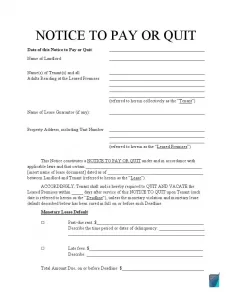
Preparing and Serving the Notice
Step 1: Find a Notice to Pay or Quit Form

The easiest way to get a pay or quit notice is to find a form that you can fill out with the specifics of your situation. There are several online forms to choose from that work well, and they can easily become your standard form whether you are a landlord for a single property or a full real estate company.
Of course, you can also work with an attorney to create a custom pay or quit notice. However, unless you already have an attorney on hand as a landlord, it may be easier to use a free version rather than pay the fees for a custom form.
Step 2: Determine How Much Back-Rent is Owed

Once you have a form, it’s important to know exactly what you are asking for, including back-rent and any late fees. You’ll need to consult your state’s rental laws since some states mandate what kind of fees can be assessed and have other rental regulations that may expand or limit your options.
It’s important to have a specific number since you’ll need to provide an itemized list of charges and fees on the notice.
Step 3: Filling Out the Form

Filling out a pay or quit notice is relatively simple but needs to be exact. You will need to fill in your tenant’s information, including the names of everyone living at the property, the address, and the date that the lease was signed.
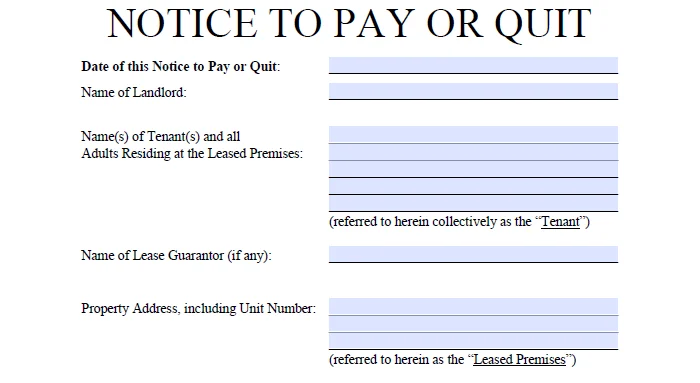
You’ll include the amount due and the dates that amount accrued without payment.
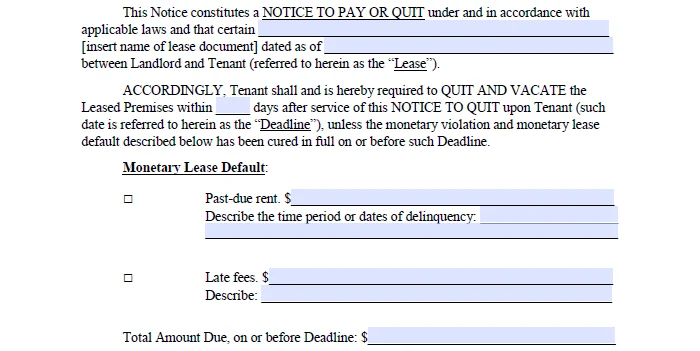
Most forms also include a certificate of service, which is required to be filled out by the person serving the notice as it is served.
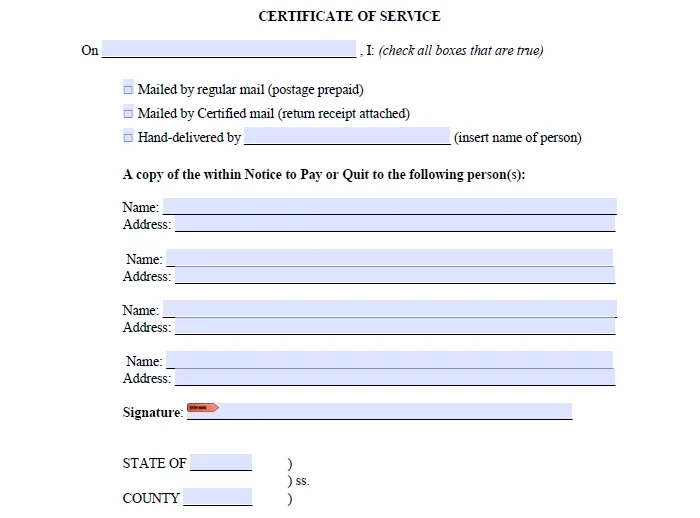
Step 4: Deliver the Notice to Pay Rent or Quit

The last step is to deliver the notice. Like many legal forms, a pay or quit notice must be served. The certificate of service included with the form is to ensure that landlords do deliver the notice to their tenants and provide sufficient time to make payment.
As a landlord, you can deliver the notice yourself in person, or you can hire an attorney or third party to serve your tenant.
A notice to pay or quit doesn’t require court involvement unless the tenant fails to make payment within the time limit and doesn’t leave the property.
What Options Does the Tenant Have?
Once you have progressed from a late rent notice to a pay or quit notice, tenants have relatively few options. Most tenants will choose to pay the rent to stay in their homes and avoid a notice to vacate. Pay or quit notices also give tenants a certain number of days to pay rent, and you’ll need to know how many days your state allows.
Giving your tenants a pay or quit notice, unfortunately, does not mean that every tenant will pay.
Some tenants will choose to ‘quit,’ meaning that they leave your property without paying back rent or forcing an eviction. Most landlords prefer to avoid this, which is why it’s important to issue notices to pay rent and pay or quit notices quickly.
That way, even if your tenant chooses to vacate the property, you haven’t lost much rent.
But tenant(s) may also choose to stay in a home even after their landlord has issued a pay or quit notice without paying rent. They can stay in the home until you obtain an eviction notice, and which point most tenants will leave before a sheriff arrives to escort them from the property.
However, even at this point, not all tenants will leave. It can be especially difficult to get tenant(s) to leave if you have a strained landlord-tenant relationship.
Other Eviction Forms
When it’s time to terminate a lease agreement, you have several eviction forms to choose from. Some are more suitable than others, but here are some of your alternatives to a notice to quit.
Standard Lease Termination Letter
Standard Lease Termination Letters are used when the landlord and tenant mutually agree to end the lease. There are plenty of reasons why that may happen, including if the tenant’s situation changes and they can no longer afford to stay at the property, or if a property needs immediate renovations or repairs.
Notice to Comply or Quit
Notice to Comply or Quit forms are used when the tenant has made all payments but has violated some other terms of their lease. For instance, if the landlord discovers that a tenant has been smoking inside a no-smoke property, and the terms are in their lease, they can issue this notice to get the tenant to comply with the lease or leave.
There are many reasons for this notice:
- Pets in a no-pet rental
- Heavy damage to the property
- More people living on the premises than allowed
- Violation of a low-noise agreement
- Unauthorized modification to the property
- Any other violation of the lease
Notice to Quit for Illegal Activity
Like notices to comply or quit, these notices can be issued even if your tenants have paid their rent in full. However, this notice isn’t a notice to bring a tenant into more acceptable behavior. Instead, it is issued when you want a tenant to leave due to reasonable suspicion that they are conducting illegal activity in or in proximity to your property.
For instance, if you have evidence that your tenant is acting as a drug dealer, you may want to issue a Notice to Quit for Illegal Activity to protect your home from future damage and repercussions if your tenant is arrested.
